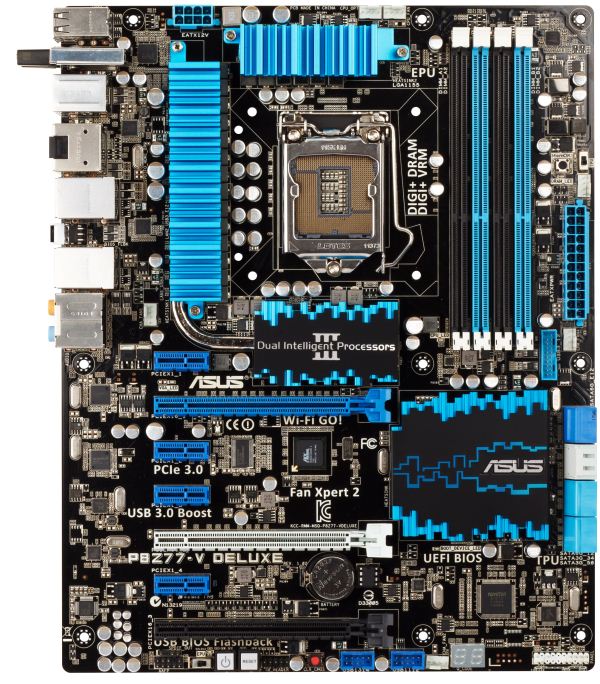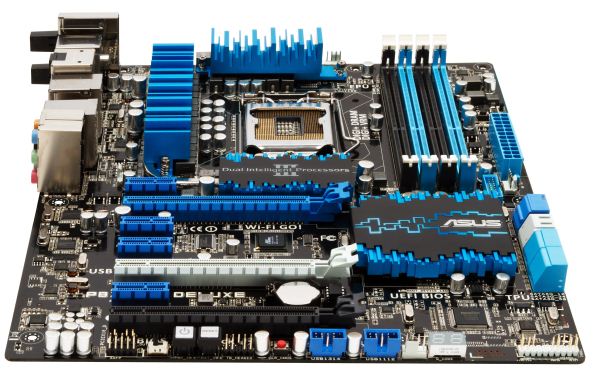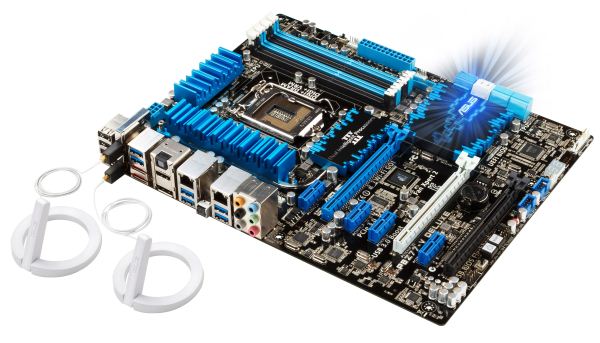Intel Z77 Panther Point Chipset and Motherboard Preview – ASRock, ASUS, Gigabyte, MSI, ECS and Biostar
by Ian Cutress on April 8, 2012 12:00 AM EST- Posted in
- Motherboards
- Intel
- Biostar
- MSI
- Gigabyte
- ASRock
- Asus
- Ivy Bridge
- ECS
- Z77
ASUS P8Z77-V Deluxe—Visual Inspection
In the next notch up in the channel board segregation, ASUS sell the Deluxe. This will be the first ASUS Deluxe board we have reviewed at AnandTech since the Llano mini-ITX F1A75-I Deluxe last year. In comparison to the P8Z77-V Pro, the Deluxe features several upgrades in terms of functionality and comfort.
The first to note is the increased power delivery to the CPU—this time in the form of a 16 + 4 phase power delivery. As a result, the VRM heatsinks to the left of the CPU are directly connected via a heatpipe to another heatsink below the socket. Also on board are the ‘enthusiast’ power/reset buttons and two-digit debug that we did not see on the Pro, and the use of dual NICs on the I/O, in the form of an Intel 82579V and a Realtek 8111F.
Due to the positioning off the heatsinks on the Deluxe compared to the Pro, the socket area seems a bit smaller (for example, the left hand heatsink is moved further in towards the socket), meaning that big air coolers may have a tougher time if they do not fit into Intel’s socket specification. Around the socket itself, we still have access to five fan headers—two 4-pin on the top of the board, one 4-pin to the bottom left of the main VRM heatsink, and one 4-pin either side of the 24-pin ATX power connector. A sixth fan header on board is found at the bottom next to the two-digit debug output.
Above the main power connector on the right hand side are the MemOK button and the TPU switch (for a fast automatic overclock). Below it is a USB 3.0 header, and a set of eight SATA ports. Similar to the ASUS Pro, we have four SATA 3 Gbps from the PCH, two SATA 6 Gbps also from the PCH, and two SATA 3 Gbps from a different controller—the Marvell 9128. This allows RAID 0/1 on these two SATA 6 Gbps ports.
The south side of the board still contains front panel headers and USB 2.0 ports, but also comes with the aforementioned power/reset buttons and two-digit debug display. We also find a ClearCMOS button on board, useful for overclockers. There is also a header labelled 'TB_Header', which should mean Thunderbolt, but there is no mention of it in the specifications. I will have to check up on this.
Update: The TB_Header is actually for a new Thunderbolt add-in card that ASUS will be selling. This is aimed to go into the x4 slot and provide Thunderbolt connectivity. MSRP will be around the $30-$40 mark so I am told.
In terms of the PCIe, we have a little bit of confusion. While in the middle between the PCIe is a PLX chip, it is not the PLX PXE 8747 chip that increases PCIe lane count. The one on the Deluxe is just to provide extra data transfer access for the various controllers on the motherboard. This means that the third full length PCIe in black is like other boards in that this is a PCIe 2.0 x4, non-GPU port. So from the top, we have a PCIe x1, x16 (x8 in Multi-GPU), x1, x1, x8, x1, x4. As a result, there is no PCIe to PCI bridge chip on this high-end model for PCI slots.
For the back panel, ASUS have done a juggling act deciding what to include. On the far left is a set of four USB 2.0 ports (black), a mini-PCIe WiFi + Bluetooth module, two USB 3.0 (blue), two eSATA, optical SPDIF output, HDMI output, DisplayPort, dual gigabit Ethernet, another four USB 3.0 ports (blue), a BIOS flashback button, and audio outputs. So in the name of a double NIC and 10 total USB ports on the back panel, we have lost D-Sub, DVI, IEEE1394 and a ClearCMOS button.
Board Features
| ASUS P8Z77-V Deluxe | |
| Size | ATX |
| CPU Interface | LGA-1155 |
| Chipset | Intel Z77 |
| Power Delivery | 16 + 4 |
| Memory Slots |
Four DDR3 DIMM slots supporting up to 32 GB Up to Dual Channel |
| Video Outputs | DisplayPort, HDMI |
| Onboard LAN |
Intel 82579V Realtek 8111F |
| Onboard Audio | Realtek ALC898 |
| Expansion Slots |
2 x PCIe x16 Gen3 (x16, x8/8) 1 x PCIe x16 Gen2 (x4) 4 x PCIe x1 Gen2 |
| Onboard SATA/RAID |
2 x SATA 6 Gbps (PCH), Support for RAID 0, 1, 5, 10 2 x SATA 6 Gbps (Marvell PCIe 9128), RAID 0, 1 4 x SATA 3 Gbps (PCH), Support for RAID 0, 1, 5, 10 2 x eSATA 6 Gbps (ASMedia) |
| USB |
Four USB 3.0 at rear (2 PCH, 2 ASMedia) Two USB 3.0 headers on board (PCH, ASMedia) Eight USB 2.0 (4 back panel, 4 on board) |
| Onboard |
4 x SATA 6 Gbps 4 x SATA 3 Gbps 1 x USB 3.0 Headers 2 x USB 2.0 Headers 6 x Fan Headers 1 x SPDIF Header 1 x Front Panel Audio Header 1 x TB Header MemOK! Button TPU/EPU Switches USB Flashback Button Power/Reset Buttons |
| Power Connectors |
1 x 24-pin ATX connector 1 x 8-pin 12V connector |
| Fan Headers |
1 x CPU Fan Header (4-pin) 4 x CHA Fan Headers 1 x OPT Fan Header |
| IO Panel |
2 x eSATA 6 Gbps 1 x DisplayPort 1 x HDMI 1.4a 2 x Gigabit Ethernet 6 x USB 3.0 4 x USB 2.0 1 x Optical SPDIF Audio Outputs Bluetooth V4.0 Wifi USB Flashback |
| Warranty Period | 3 Years |
| Product Page | Link |
Obviously one of the main selling points of the board is the onboard WiFi and Intel NIC (alongside a Realtek NIC).














145 Comments
View All Comments
MrSpadge - Sunday, April 8, 2012 - link
"multiples of 15 Hz (15, 30, 35, 60, 75)" on page 2Ryan Smith - Sunday, April 8, 2012 - link
Got it. Thanks.MrSpadge - Sunday, April 8, 2012 - link
How does it work together with nVidias adaptive VSync, which debuted with the GTX680? And which, IMO, looked quite promising (lowering average power consumption a lot while gaming).Ryan Smith - Sunday, April 8, 2012 - link
You wouldn't use MVP with Adaptive V-Sync. It only makes sense to use MVP by itself.Thaine - Thursday, August 16, 2012 - link
"Predicting which frames (or rendering tasks) will never be shown and taking them out of the pipeline so the GPU can work on what is needed"Along the lines of power consumption (and the ever-important side effect, heat), I would be very interested in seeing an article on MVP vs power consumption/heat on a power-hungry dGPU (ala GTX 480).
primonatron - Sunday, April 8, 2012 - link
Not sure why most of these boards bother including the non-Intel USB 3.0 controllers any more.Not many people have several USB 3.0 devices, so they could be saving costs. Or instead bringing back some of the things the article mention were taken away - like DVI on an ASUS board.
GreenEnergy - Sunday, April 8, 2012 - link
I think board makers are getting desperate for ways to add value.Less and less components to change and diversify with.
And its not getting better in the future. Haswell on LGA1150 basicly removes the entire VRM part on the motherboard. No more 32 phases or whatever.
A 50$ board performs identical to a 200$ board if you dont overclock. Actually the 50$ board might be more reliable (less components to fail) and more power efficient.
Xale - Sunday, April 8, 2012 - link
50 dollar boards are probably going to at least boot faster. The driver load and POST times with many 3rd party controllers, SATA especially, is atrocious. Seen some boards that take nearly 3x longer if the external controllers aren't disabled.Metaluna - Sunday, April 8, 2012 - link
Mostly marketing I would guess. Intel only supports 4 3.0 ports, so if you add another chip you now have a checklist item to justify the premium price of your motherboard and possibly differentiate it from lower-end versions in the same product line.Second, ASUS owns ASMedia, who makes a lot of the (mediocre, IMHO) USB 3 and Bluetooth controllers on their boards, so there's probably an incentive to use them in their own products to help prop up their production volumes.
Third, a lot of the third party controllers have special modes to support things like high-current charging for iPads or charging when the computer is turned off. Does anyone know if it's possible to add these features to Intel-based ports? If not, that would be an incentive to include a secondary chip.
GreenEnergy - Sunday, April 8, 2012 - link
I saw the DH77DF im looking at myself got high current recharge. So that doesnt seem to be related to the controller at all.